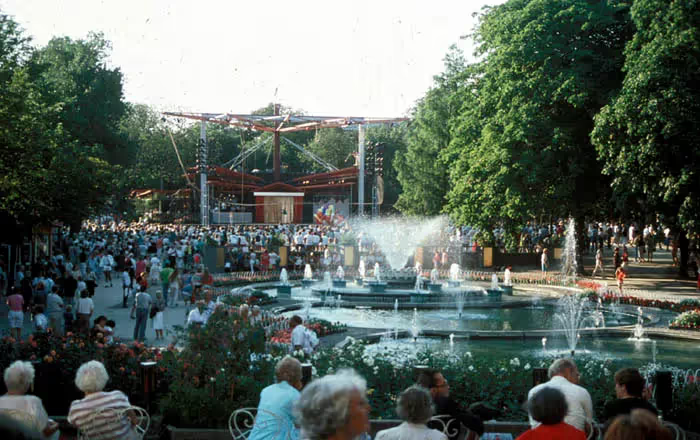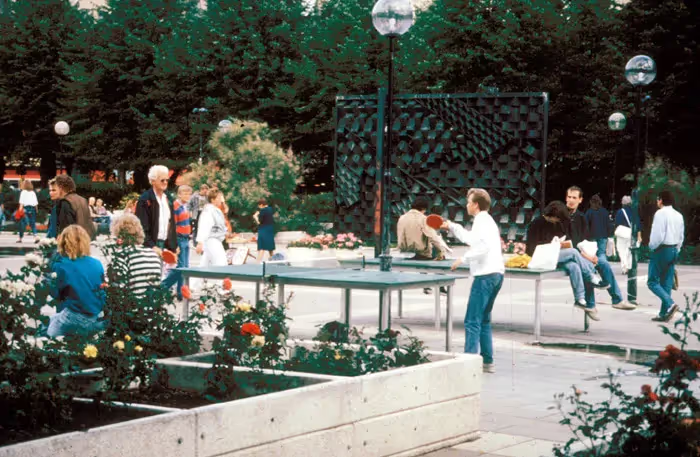A biweekly newsletter with public space news, resources, and opportunities.
A curated dispatch on all things public markets plus the latest announcements from the Market Cities Program.
Please note that these Hall of Shame nominations were written in a moment in time (most over a decade ago) and likely have since changed or even been transformed. If the above entry is now great, or still not so great, go ahead and comment below on how it has evolved or nominate it as a great place.

The 400m x 100m "King's Garden" is variously described as a park, town square, amusement park, and botanical garden.

Kungstradgarden has thrived as a public place primarily because of the ability of its management to accommodate such a wide range of seasonal uses. One of the main elements in the Kungstradgarden is a large tent covering a major stage, where performances take place nearly every day during the warm months. In total, nearly 150 stage events occur there each year, in addition to 100-150 days of exhibitions, a Christmas market on December weekends, and a host of other activities. There are also restaurants at the two ends of the garden and rows of trees along both sides. A sunken fountain area with steps is situated in front of one restaurant, and the garden's center features a large, circular plaza that becomes the skating rink in winter.
Though there are a variety of warm-weather activities such as chess, checkers, and ping pong, for which the equipment was available in a small red wooden house, these activities no longer occur to the extent they once did. The garden was redesigned in 1998, and while formerly there was nowhere like it in the world in terms of flexibility, the resulting layout is more rigid and makes many of these activities no longer possible. Also removed in the redesign was also a demonstration playground featuring the latest designs for children's play equipment. In all, however, Kungstradgarden remains a popular, wonderfully airy place in the heart of the city center - and compared to most places, it still hosts an impressive array of events, activities and performances in every season, sponsored by local businesses and organizations.
Activities are run by Kungstradgarden Park & Evenemang AB (KPE), a wholly-owned subsidiary of the Stockholm Chamber of Commerce. The City appoints representatives to the board. Everything you see and hear is financed by the Park itself in a closed economic circuit; no tax money, no national nor regional subsidies are included in the financing of the activities. The Stockholm Real Estate, Streets & Traffic Department (GFK) is in charge of the trees, the vegetation, the cleaning and lighting, while the Recreation Administration operates the skating rink. Rental income from kiosks, restaurants and tea gardens constitutes the general funds for the financing of the activities in the King's Garden. The stage, equipped with a sound and light outfit, technical staff and a production department, can be hired - together with park grounds - for large arrangements, campaigns or exhibitions. The generated surplus profits are used for the programmed productions of the park itself and to the maintenance of the scene, bunting, chess and vegetation. In this manner, the money stays within the King's Garden to offer entertainment to the visitors.
Located in the heart of the Stockholm and adjacent to the palace, Kungstradgarden owes a little to each of its past incarnations, from royal kitchen garden to lush public park to army drill-ground. Kungstradgarden was transformed in 1562 from the Royal kitchen garden to a pleasure garden under the direction of the French designer Jean Allard. Since then, the park has been modernized several times. At the end of the 18th Century "the common and curious public" gained entrance and the liveliness of the park attained new heights. The Park was modernized several times in accordance with changing fashions. During the 19th century, its lawns, flower borders and various trees were eliminated and the garden was transformed into a drill-ground. Only the allees of trees were preserved. In order to create festivity grounds for Stockholm's 700th birthday celebrations during the summer of 1953, the King's Garden was once again extensively modified: waste gravel pits became a summer scene with sweets-stalls, open air cafes and fountains.
In 1953 it became the site of Stockholm's 700th birthday festivities, and the central portion has been managed continuously since then as a flexible event and performance space. It has also long been the arena of Swedish premieres: In 1953, the first hot dog was served there, and it was also in the King's Garden that Piccolino introduced espresso and cappuccino, to the delight of Swedish palates. In 1962, the first artificially frozen skating-rink was inaugurated in the park, and the first outdoor chess set was put up in the beginning of the seventies.




*Please note that these Hall of Shame nominations were written in a moment in time (most over a decade ago) and likely have since changed or even been transformed. If the above entry is now great, or still not so great, go ahead and comment below on how it has evolved or nominate it as a great place.